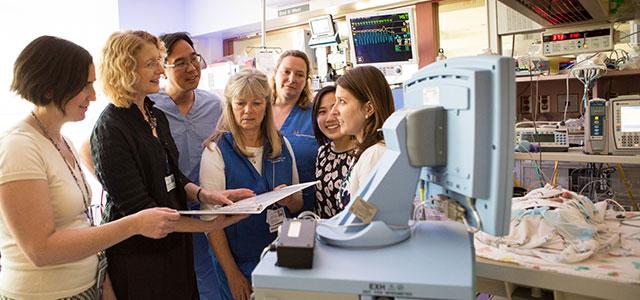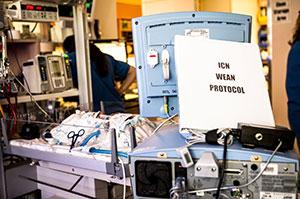
(Left to right) Sarah Scarpace Lucas, Linda Franck, Thomas Shimotake, Linda Lefrak, Robin Bisgaard, Fiona Ng and Sylvia Stoffella
Optimizing Pain Management While Preventing Opiate Withdrawal in Postoperative Newborns
It’s an agonizing example of the law of unintended consequences.
Lifesaving advances in neonatal surgery lead to postoperative pain. Then, when clinicians dramatically improve pain management, they have to wrestle with the side effects of opiate use, including potentially life-threatening withdrawal symptoms.
“My patients sometimes barely convalesce from surgery, only to have to cope with withdrawal symptoms,” says Robin Bisgaard, a 28-year veteran nurse in the William H. Tooley Intensive Care Nursery (ICN) at UCSF Benioff Children’s Hospital San Francisco.
“Unfortunately, because managing infant pain is a fairly recent development, how best to wean infants from pain medication is something we are still learning about,” says Linda Franck, an internationally recognized expert in pediatric pain management at the UC San Francisco School of Nursing.
Franck intends to learn more. She and an interdisciplinary group of clinicians from the ICN at UCSF Benioff Children’s Hospital recently launched a study aimed at optimizing and standardizing weaning protocols for postoperative infants on pain medications.
Dangerous Side Effects
According to Linda Lefrak, a clinical nurse specialist in the UCSF ICN, the objective indicator of withdrawal in an infant is failure to thrive, but there are numerous subjectively measured indicators, including tremors, not eating, low-grade fever, vomiting, diarrhea and, in severe cases, seizures.
In an adult, something like diarrhea might just be unpleasant, but in a newborn, the dehydration associated with it can be very dangerous, says Lefrak. Concerns about such dangers sent Bisgaard to Franck, a mentor who had already begun to research ways to better monitor and manage the weaning process.
“Babies get weaned from other things – ventilation, steroids – the concept is not new. In pain management, however, there’s been a sense that infants can come off medication quickly, but we now know that weaning too quickly can be harmful to babies,” says Franck.
“The algorithms are complicated, and there is a real knowledge deficit among care providers,” says Lefrak. “You can’t just cut the dose in half and then stop.”
The nurses found a receptive audience in other members of the ICN team, including neonatologist Yao Sun, medical director of the ICN.
“There is really good awareness right now in terms of how important pain control is in infants – we continue to make progress with pharmacologic and therapeutic approaches. But because we haven’t paid quite as much attention to how to best stop the medication – and because there is a lack of evidence – there’s also been a lack of consistency in how individual teams approach weaning,” says Sun.
With the ICN’s strong emphasis on team-based care – physicians, nurses, pharmacists and others round together – it made sense to have an interdisciplinary team design, implement and evaluate the efficacy of an intervention to improve opiate weaning.
“We knew that if everybody sat down at the table and each of us spoke on behalf of our discipline, something good could come about,” says Bisgaard.
Creating the Protocol
As a starting point, the group agreed on its own version of a triple aim: optimize pain control while minimizing exposure to opiates and length of stay; hospitals can be dangerous places for infants.
Pediatric pharmacy resident Sylvia Stoffella began drafting a protocol as her required residency research project, with the supervision of pediatric clinical pharmacist Sarah Scarpace Lucas of the UC San Francisco School of Pharmacy.
“The American Academy of Pediatrics recommends a standardized weaning protocol, and literature in older children indicates that having a regimented plan has improved patient outcomes,” says Stoffella. “We would expect, following a similar process, we would get a similar outcome.”
 Stoffella based her protocol on what little research existed for infants, including work done weaning those who had been exposed during pregnancy because of their mother’s opiate use.
Stoffella based her protocol on what little research existed for infants, including work done weaning those who had been exposed during pregnancy because of their mother’s opiate use.
The new approach dictates that any infant exposed to five days or more of opiates should be entered into the study and clinicians should implement the protocols – flowcharts informed by algorithms that depend not just on length of time and drug doses, but also on symptoms as assessed by the nursing staff using a weaning assessment tool (WAT-1) that Franck developed with Martha Curley, from the University of Pennsylvania School of Nursing. The tool is used to monitor opiate weaning in hospitalized pediatric patients, but its use with newborns is a more recent development.
First published in 2008 and validated in 2012, the WAT-1 was the first tool to measure withdrawal symptoms from hospital-administered opiates in children. Before the WAT-1, nurses used unvalidated adaptations of the Finnegan Neonatal Abstinence Scoring System, which was developed to score symptoms in babies who are withdrawing from exposure to opiates during pregnancy. The WAT-1 has the advantages of a shorter list of symptoms and twice-a-day administration, as opposed to every four hours for the Finnegan.
“We’re just finishing a 31-site, NIH-funded study in PICUs, led by Dr. Curley, to look at an analgesic sedation protocol, including weaning based on WAT-1 scores,” says Franck. “In the meantime, hospitals across the world are adopting the WAT-1, and nurses say that it really helps them give better care to their patients; we’re very proud of this work.”
Once the team agreed on the protocol, members reviewed medical records for the prior three months to establish baselines for length of stay, time on opiates and patient symptoms, which would allow the team to gauge the success of their efforts.
The review also helped them decide who would do what in the actual implementation. Each member of the team is responsible for identifying babies who need to go on the protocol. Nurse practitioners and neonatologists might identify candidates after prompting from the bedside nurses, or pharmacists will notice that infants have been on opiates for five days and insert a note in the chart.
“At some point, we hope [our electronic medical record] will pop up an advisory when it’s appropriate to start the wean protocol, but we can’t do that just yet,” says Lefrak.
Once the protocol is set in motion, nurses will use the WAT-1 to assess symptoms, and pharmacists will monitor patient weight, dosage and length of time on the opioid therapy to help personalize and adapt the wean as necessary.
“We’re hoping that by working with the nurses monitoring symptoms, we can wean more quickly while still managing pain appropriately, because the best thing is to get these infants off the medications,” says Scarpace Lucas.
“The protocol also specifies nonpharmacologic ways to help patients in terms of pain control,” says Sun. “That’s important, because that too has not been consistent in the past. In infants, we’re a little bit constrained on these methods – infants can’t actively participate – but we can still use touch, positioning, parental presence and comfort.”
Overcoming Implementation Challenges
Of course, it’s one thing to conceive of a protocol in the abstract and another thing entirely to implement it in a unit that includes more than 100 nurses and 80 rotating residents, as well as multiple neonatal nurse practitioners, pharmacists and attending neonatologists – all of whom need to be on board.
Aware of the challenge, the central team (Bisgaard, Franck, neonatologist Gavin Henderson, Lefrak, Scarpace Lucas, Stoffella and Sun) began by soliciting feedback from clinicians on the unit and then moved the protocol through the governing hospital committees. Once it was approved, they turned their attention to educating all relevant staff.
“We have to make sure everyone is aware of the guidelines for weaning and pain assessment – not just physician and nursing teams, but also the pharmacists and others who may do procedures that need pain awareness, like the respiratory therapist,” says Sun.
To that end, there was a series of mandatory in-services for each of the various disciplines. Bisgaard, Franck and Lefrak, in collaboration with the UCSF Medical Center Learning and Organizational Development group within the UCSF Institute for Nursing Excellence, created an online education module for nurses, which has proved so useful that other disciplines have used it as well. Getting nurses to accept the WAT-1 was of particular concern, because they were so familiar with the Finnegan assessment tool and needed to be convinced, through evidence-based literature, of the need for change.
“Trying to learn a new approach to something always requires more energy, more thought and, frequently, more time – and that can be difficult to accept,” says Sun.
“I feel very lucky to have Linda Franck’s leadership, as the author of WAT-1, so we can make sure we’re educating folks correctly,” says Bisgaard.
Then there is what happens when you actually have a patient. For example, in the past nurses waited to score patients until they received an order to do so. Now, they don’t require a direct order, and that means changing ingrained work patterns in the midst of a busy, high-pressure environment.
Similarly, all assessments are somewhat subjective. Though scoring is an attempt to remove as much subjectivity as possible, Lefrak points out that nurses still have to distinguish between such things as moderate and severe tremors or take several minutes to observe how a baby calms after being touched, and this can be challenging when they are dealing with other patients with important needs.
“You can present something, but until you work with it and use it, it’s not real,” she says.
Consequently, when a patient is enrolled in the weaning protocol, the primary care team and nursing staff receive a notification, and the assessment tools and appropriate protocol adaptations are placed at the bedside. There is always a group of people – a version of super users – available to help with questions as they come up and to encourage people to use the protocol. In addition, the core group meets monthly, sometimes twice a month, to review how well they are meeting project goals.
Interdisciplinary Buy-In
While it is still early in the process – at the writing of this article, only a couple of patients at the William H. Tooley ICN had qualified for enrollment since the protocol study was launched on April 7 – the team is confident the effort will lead to the type of standardization they seek and be an important advance for patient care.
“The fact that we could come together from different professions and create and implement this protocol in less than a year is amazing,” says Stoffella. “We needed all of the disciplines to be involved, and it really helped that all of us understood the need. Not everyone agrees with everything or got on board right away, but it helped to have clear goals and to be willing to listen and negotiate – and having a champion from each profession makes a difference.”
“It’s been fantastic to work with expert colleagues in the UCSF Benioff Children’s Hospital ICN,” says Franck. “There is nothing more rewarding than creating something that will improve the lives of newborns everywhere.”
“This truly is a collaborative project.… Everyone has had an important contribution, everyone listened respectfully and everyone’s goal is the same,” says Bisgaard.



